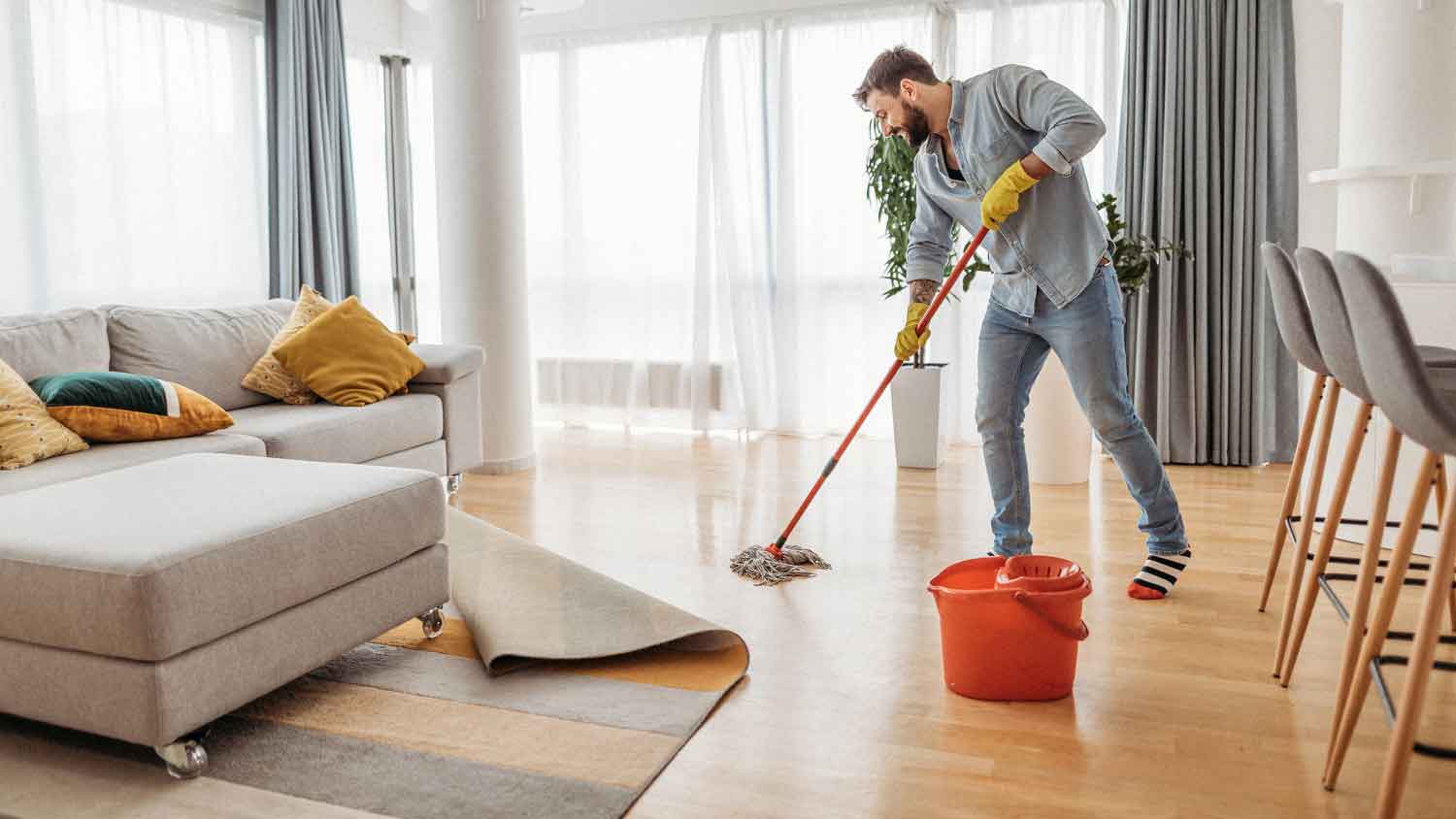11 Cleaning Hacks Everyone Should Know
Follow these 11 essential cleaning hacks for a home that shines in no time


The internet is full of cleaning hacks that promise to change your life—or at least make things easier. We’ve rounded up these 11 cleaning hacks that everyone should know because they’re not only useful, they’re also easy to do. Follow these tips and you’ll be living in a house that sparkles and shines without putting in hours and hours of effort.
1. Make a Cleaning Checklist and Chore Wheel
This might be the ultimate cleaning hack. Every project needs some kind of management, including cleaning and maintaining your home—which can really be considered an ongoing project with major milestones like spring cleaning or renovations.
Creating a house cleaning checklist that includes individual assignments for different members of the household (if applicable) can be an incredible way to keep things organized.
For instance, someone could be responsible for vacuuming every Tuesday and Friday, while someone else could be in charge of weekly bathtub scrubbing duties. If you’re the one in charge of maintaining the home, a checklist can take things off your plate and help to teach your family the importance of working as a team. Plus, there is something so satisfying about checking completed things off a list.
2. Make DIY Cleaning Solutions With Vinegar, Baking Soda, Lemons, and More
Did you know that you probably already have some great cleaning supplies in your kitchen or pantry, or that you can even make your own cleaning supplies?
You can clean and refresh tons of things with lemons. Banish smelly sinks by using a lemon and coarse salt to scour the basin and then running the citrus halves or quarters through the garbage disposal. Using lemons to freshen things up is also one of our favorite microwave cleaning hacks (hey, there is a reason that so many commercial products are citrus scented).
“Cleaning one's home can often be time-consuming. If you do not have the luxury of hiring a house cleaning specialist, the next best thing is making your own cleaning supplies with natural solutions and/or essential oils,” said Asya Biddle, Angi Expert Review Board member and manager of The Dustbusters, a family-owned and operated janitorial company in Williamsport, PA. “While we are unable to use such cleaners in a commercial or medical facility, homemade cleaners will get the job done for a fraction of the price and leave your house smelling amazing."
Baking soda and vinegar can clean the rest of your kitchen and keep your bathroom sparkling clean as well—no other products needed, just a little elbow grease. Vinegar can get tough stains off of small appliances like coffee makers or blenders or even unclog showerheads.
You can also use a mixture of baking soda, water, and vinegar to clean your oven—it’s one of our favorite oven cleaning hacks. A mixture of baking soda and vinegar is also a good way to clean your washer and dryer and prevent mildew from developing. Just sprinkle about half a cup of baking soda into the drum or basin of your washing machine and run it on the hottest cycle, then wipe the inside and outside down with white vinegar.
Baking soda is also surprisingly good at removing stubborn grease or oil stains on fabric, carpet, or upholstery. Vinegar can help remove candle wax or anything that’s left a sticky residue. Just sprinkle some on the offending spot(s) and leave it for a while to soak things up, and then wipe away the problem.
3. Use Unexpected Items as Cleaning Tools
Getting rid of socks with holes in them or pillowcases with stains is a major cleaning mistake, as you can totally use them for cleaning. Pillowcases are great for wiping down ceiling fans, for instance, and putting a sock over your hand can be an easy way to clean finicky items like window blinds.
Even toothpicks and cotton swabs can be surprisingly helpful to get grit or dirt out of small spaces or grooves in between tile or furniture with small details.
4. Vacuum Everything You Can
A vacuum or shop vac can be your best friend when it comes to cleaning for a variety of reasons. You can vacuum inside everything from an oven to a fridge to cupboards and get out dust, dirt, and other debris.
Once you’ve gotten excess dirt out, you get down to wiping things out and disinfecting them. You can also use vacuum hoses to clean upholstery and mattresses, or get the dust off crown moldings, built-in shelving, and anywhere else that’s hard to reach.
5. Optimize Your Vacuuming
Speaking of vacuums, make sure you get the most out of yours. Extend your vacuum hose with a piece of PVC pipe or two and some couplings or fittings from your local hardware store so you can easily reach high-up or otherwise inconvenient spots. You may also want to rent or borrow a steam cleaner or get a professional carpet cleaning once a year or so—add that to your cleaning checklist.

6. Keep Your Cleaning Tools Pristine
It’s hard to keep the rest of your house clean if the equipment that you use is part of the problem. Make sure that any mops, brooms, vacuums, wash rags, spray bottles, and any other cleaning supplies are in good condition. Replace and refill everything on a regular basis.
Changing your vacuum bag or emptying the canister (in the case of a bagless vacuum) right after you use it is always a good idea. You’ll also want to regularly clean your washer and dryer to prevent odors and mildew from settling into your clothes, sheets, and towels.
7. Use What’s Already Around Your Home
Lots of standard household items can do double or triple duty.
For example, lint rollers are great for cleaning lampshades and tough spots like the tufts between buttons on upholstered furniture. Coffee filters get the dust off of delicate electronics and screens safely and easily.
Dryer sheets are even more versatile. These little sheets can do everything from eliminating the caked-on grime from pans (just soak the pan in water with a dryer sheet or two tossed in) to neutralizing odors (just toss a couple in the bottom of dirty laundry hampers, trash cans, or underneath any pet-related items like crates, tanks, or litter boxes).
8. Use Markers for Scratched Floors and Furniture
You can fix scratches on wood, laminate, or painted surfaces with markers or gel paints. Just get a paint marker, wood finish stain marker, or alcohol-based marker, that matches the shade of the material and color over the marks. A bit of olive oil rubbed in can restore shine and help fill in scratches as well.
9. Use a Spray Bottle Instead of a Bucket
Need to clean your floors and walls? Spritzing on a cleaner instead of mopping with a bucket is easier and may even be more sanitary. You’ll also likely use less cleaner if you mix it in a spray bottle versus a bucket. Plus you can spot clean more easily with a spray bottle and rag or mop too.
10. Keep a Soap Dispenser Brush, Squeegee, and Cleaners in Your Shower
Every time you take a shower or bath, give the shower a quick wipe down right away so soap scum and dirt don’t have time to build up. Be sure to spray the shower curtain liner and use the soap dispenser brush to get under the bath or shower mat too, since that’s where gross mildew and mold can hide.
If you have glass shower doors, keep a squeegee tool in there as well and clean them quickly post-shower to avoid cloudiness and smears. Pro tip: If a buildup does occur on your glass shower doors, you can first use a wet eraser sponge to remove the soap scum and then a streak-free glass cleaner to make the glass shine.
11. Combine Tasks to Save Cleaning Time and Effort
Once you’re already in cleaning mode, make things efficient by combining similar tasks. Wash towels while you wash sheets, get the baseboards clean, or hit the upholstery with a vacuum extension while you are vacuuming, clean out the freezer and cabinets while you do the fridge, or clean the blinds while you are washing the windows.





- The Ultimate Room-by-Room Spring Cleaning Checklist
- 26 House Cleaning Tips to Elevate Your Cleaning Game
- Learn How to Clean Your House (and Maybe Even Have Fun Doing It) With These 27 Tips
- 17 Tips for Sparkling-Clean Appliances, From Dryers to Dishwashers
- 10 Cleaning Shortcuts That Will Speed Up Your Chores
- These Are the Best Tools for Cleaning Hard-to-Reach Areas
- 10 Tips for Disinfecting Your Bathroom
- How to Clean the Exterior of Your House Like a Pro
- How Often Should You Clean Your Bathroom?
- 17 Tips for Cleaning With Vinegar and Baking Soda











